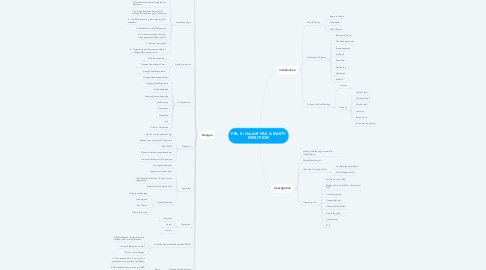
1. Dengue
1.1. What is Dengue?
1.1.1. DENV-1, -2, -3, -4
1.1.2. Flaviviridae
1.2. Causes
1.2.1. Transmitted by Aedes mosquitoes
1.2.1.1. Mainly: Aedes aegypti
1.2.1.2. Rarely: Aedes albopictus
1.2.2. Most common: DENV-2
1.3. Risk Factors
1.3.1. Live/ Travel in tropical areas
1.3.2. Immunocompromised
1.3.3. Secondary infection
1.3.4. Have 2 / more serotypes in body
1.4. Pathophysiology
1.4.1. 1. Infection of immature Langerhans cell & kerationcytes
1.4.2. 2. Binds & enters the cell cytoplasm as endosome
1.4.3. 3. Cell cytoplasm becomes acidic & endosomal membrane gains -ve charge
1.4.4. 4. Viral RNA genome in the nucleocapsid is released
1.4.5. 5. Translation of viral RNA genome
1.4.6. 6.Immature viruses go through Golgi apparatus & leave the cell
1.4.7. 7. Infection is amplified
1.4.8. 8. Triggers strong inflammatory infection --> dengue haemorrhagic fever
1.5. Sign & Symptoms
1.5.1. Mild Dengue Fever
1.5.1.1. Muscle & Joint ache
1.5.1.2. Rash
1.5.1.3. High fever
1.5.1.4. Headache
1.5.1.5. Pain behind the eyes
1.5.1.6. Vomiting & Nauseous
1.5.2. Dengue Hemorrhagic Fever
1.5.2.1. Bleeding (mouth, gums, nose)
1.5.2.2. Clammy skin
1.5.2.3. Lymph & blood vessels damage
1.5.2.4. Internal bleeding
1.5.2.5. Sensitive stomach
1.5.2.6. Petechiae
1.5.2.7. Weak pulse
1.5.3. Dengue Shock Syndrome
1.5.3.1. Intense stomach pain
1.5.3.2. Disorientation
1.5.3.3. Sudden hypotension
1.5.3.4. Heavy bleeding
1.5.3.5. Regular vomiting
1.5.3.6. Blood vessels leaking fluid
1.6. Complications
1.6.1. Dengue Haemorrhagic Fever
1.6.2. Dengue Shock Syndrome
1.6.3. Cardiomyopathy
1.6.4. Seizures & encephalopathy
1.6.5. Hepatic injury
1.6.6. Depression
1.6.7. Pneumonia
1.6.8. Iritis
1.6.9. Orchitis / Oophoritis
1.7. Diagnosis
1.7.1. Nucleic acid amplification test
1.7.2. Dengue virus antigen (NS1) detection
1.7.3. MAC-ELISA
1.7.4. Plaque reduction neutralization test
1.7.5. Immunohistochemical (IHC) analysis
1.8. Treatment
1.8.1. No specific treatment
1.8.2. Paracetamol: reduce fever
1.8.3. Oral rehydration therapy / IV fluid: reduce dehydration
1.8.4. Platelet & blood transfusions
1.8.5. Alternate therapy
1.8.5.1. Papaya leaf therapy
1.8.5.2. Orange juice
1.8.5.3. Basil leaves
1.8.5.4. Crab & frog soup
1.9. Prevention
1.9.1. Individual
1.9.1.1. Long-sleeved clothings + Permethrin
1.9.1.2. Insect repellants
1.9.1.3. Controls mosquitoes indoors & outdoors
1.9.2. Project
1.9.2.1. Wolbachia Initiative
1.9.3. Vaccine
1.9.3.1. Dengvaxia
1.9.3.1.1. Effective aginst sero+ve people
1.9.3.1.2. ↑ risk of severe dengue in sero-ve people
1.9.3.1.3. Efficacy: ↑ in serotypes 3 & 4
1.9.3.2. Takeda
1.9.3.2.1. In Phase 3 trial
1.9.3.2.2. Efficacy: ↑ in serotypes 1 & 2
1.10. Antibody-Dependent Enhancement (ADE)
1.10.1. DIfferent dengue serotypes bind to antibody from primary infection
1.10.2. ↑ in overall replication of virus
1.10.3. ↑ Risk of severe dengue
1.11. Dengue Cross-Reactivity
1.11.1. Steps
1.11.1.1. 1. Cross-reactive Abs --> entry of non neutralized virus-antibody complexes
1.11.1.2. 2. Ab-mediated entry of virus into MPC
1.11.1.3. 3. Infected MPC= reservoir
1.11.1.4. ↑ Viral progeny
1.12. Epidemiology
1.12.1. Endemic in >120 contries
1.12.2. Estimated 390 mil infection/year
1.12.3. WHO: Infected & death cases increase gradually
1.12.4. High risk nations
1.12.4.1. Ranked 4th: Sri Lanka
1.12.4.2. Ranked 8th: Malaysia
1.13. Why is it hard to control in Malaysia?
1.13.1. Equatorial climate
1.13.2. ↑ population density
2. Introduction
2.1. Hajar & Family
2.1.1. Return to village
2.1.2. Hot weather
2.1.3. Has 3 children
2.2. Presenting Complaint
2.2.1. Burning hot body
2.2.2. Pain behind eyeballs
2.2.3. Severe headache
2.2.4. Joint pain
2.2.5. Sore throat
2.2.6. Flushed face
2.2.7. Nauseated
2.2.8. Vomited
2.3. Dr Azan's Clinical FIndings
2.3.1. Present
2.3.1.1. Raised temp
2.3.1.2. Sore throat
2.3.1.3. Injected pharynx
2.3.1.4. Conjunctival injection
2.3.1.5. Faint Petechiae
2.3.2. Absent
2.3.2.1. Chills & rigor
2.3.2.2. Abdominal pain
2.3.2.3. Muscle ache
2.3.2.4. Jaundice
2.3.2.5. Runny Nose
2.3.2.6. Blood stained sputum
3. Investigation
3.1. History of Presenting Complaint & History Taking
3.2. Physical Examination
3.3. Hess Test / Tourniquet Test
3.3.1. Capillary fragility markers
3.3.2. Test for dengue fever
3.4. Laboratory Test
3.4.1. Full blood count (FBC)
3.4.2. Packed cell volume (PVC) / Haematocrit (HCT)
3.4.3. Liver function test
3.4.4. Dengue IgM test
3.4.5. Indirect IgG ELISA test
3.4.6. Simple rapid test
3.4.7. Virus isolation
3.4.8. PCR

